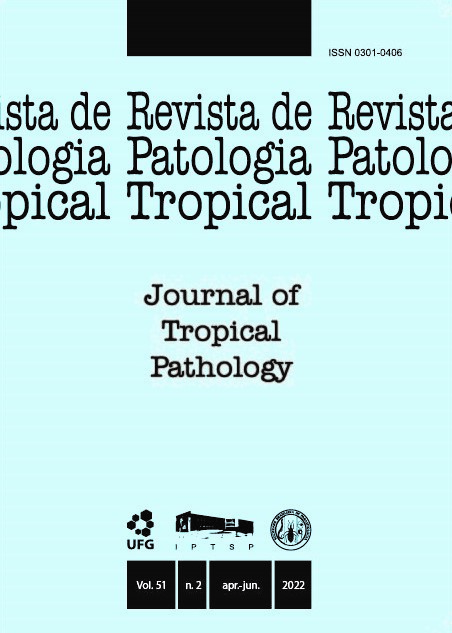Molecular detection of anaplasmataceae agents on dogs from the departament of Piura, Peru
DOI:
https://doi.org/10.5216/rpt.v51i2.71516Resumo
This study aimed to study the prevalence of Anaplasmataceae organisms through the nested-PCR and phylogenetic analysis on domestic dogs in the Department of Piura, Peru. Two hundred and twelve canine blood samples were randomly collected on dogs from the central urban areas at the Piura Department in Peru. The extracted DNAs were tested, by nested-PCR based on 16SrRNA gene, to identify agents from Anaplasmataceae family. These results show that there was a prevalence of 18.5% (40/216) of positive dogs, 13.8% (30/216) for Ehrlichia canis, 7.4% (16/216) for Anaplasma platys and 0.1% (2/216) for Ehrlichia sp. confirmed by sequencing analysis. Co-positivity among Anaplasmataceae family species was present in 25% (10/40) of positive samples. There was a significant association among Anaplasmataceae family infection in dogs and the following variables: sex (p=0.034), presence of ticks (p=0.0001), and socio-economic status (p=0.001). There was no statistical association on the variables “living with other animals” and “age group” (p=0.1074). The partial sequences on the portion of the 16S rRNA gene, from positive samples for agents of Anaplasmataceae family demonstrated an identity of 97-100% with the isolated E. canis and A. platys obtained from the GenBank. This is the first study on infection by agents of Anaplasmataceae family in dogs in the Department of Piura, through molecular analysis.
KEY WORDS: Anaplasmosis; Canis lupus; ehrlichiosis; molecular analysis; South America
Downloads
Downloads
Publicado
Como Citar
Edição
Seção
Licença
The manuscript submission must be accompanied by a letter signed by all authors stating their full name and email address, confirming that the manuscript or part of it has not been published or is under consideration for publication elsewhere, and agreeing to transfer copyright in all media and formats for Journal of Tropical Pathology.

